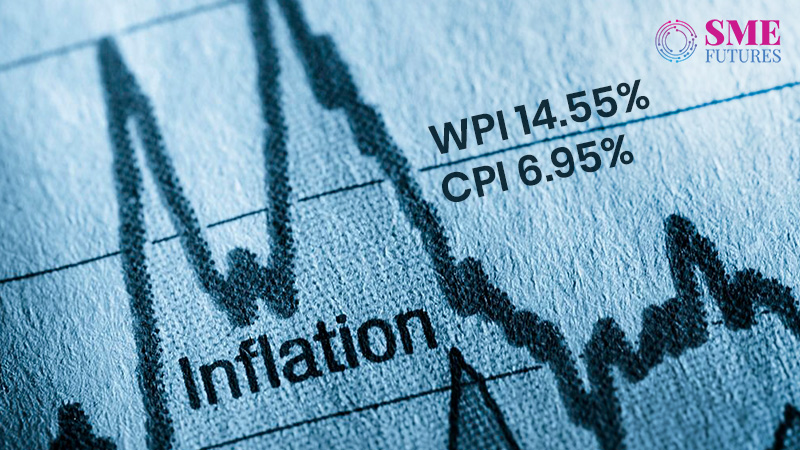The skyrocketing prices of basic commodities like food items, fuel and petrol, clothing, etc., make it hard for a common man to attain his daily necessities even.
The high cost of ‘fuel and power’ due to the Russia-Ukraine war pushed up India’s March 2022 wholesale inflation to a 4-month high level. Accordingly, the annual rate of inflation, based on wholesale prices, rose to 14.55 per cent last month from 13.11 per cent reported for February 2022.
Similarly, on a year-on-year (YoY) basis, the Wholesale Price Index (WPI) data furnished by the Ministry of Commerce and Industry showed an exponential rise last month over March 2021, when it stood at 7.89 per cent.
“The annual rate of inflation is 14.55 per cent (provisional) for March 2022 (over March 2021) as compared to 7.89 per cent in March 2021,” the Ministry said in its review of ‘Index Numbers of Wholesale Price in India’ for March.
“The high rate of inflation in March 2022 is primarily due to rise in prices of crude petroleum and natural gas, mineral oils, basic metals, etc., due to disruption in the global supply chain caused by the Russia-Ukraine conflict.”
Besides, the month-over-month change in the WPI index for March 2022 stood at 2.69 per cent as compared to February 2022.
As per the data, the segment of the primary article, which has one of the highest weightage in the WPI, increased at a faster rate of 15.54 per cent in March as compared to 13.39 per cent reported for February 2022. Consecutively, the Consumer Price Index-based inflation stood at 6.95 per cent as reflected by data by the Ministry of Statistics and Programme Implementation (MoSPI). CPI is commonly called Retail inflation.
Speaking on the CPI inflation, Dr. Arun Singh, Global Chief Economist, Dun & Bradstreet said, “Energy, industrial metals, and agri-commodity price shocks are a major risk to growth. Elevated input prices along with a rise in interest rates are expected to weigh upon the profitability of companies when they were just recovering from the 3rd wave. Prices of all commodities are on a rise and the outlook is set to worsen amidst disruptions in global supply chains, rising freight costs, and sanctions imposed on Russia,”
“We expect retail prices to rise further as the hike in domestic fuel prices is yet to be factored into the inflation data. Policy repo rate might not increase at least in the next MPC meeting as there has been an effective increase in interest rate by 40 bps with the introduction of the standing deposit facility. However, the RBI will be under pressure if geopolitical risks further aggravate.” he adds.
In the fuel and power segment, which has a weightage of 13.15 per cent, the rise in inflation was recorded at 34.52 per cent from 31.5 per cent in February 2022. The cost of manufactured products, which has a weightage of 64.23 per cent, increased at a faster rate of 10.71 per cent from 9.84 per cent.
Similarly, the growth rate of the WPI food index, consisting of food articles from the primary articles group and food products from the manufactured products group, rose to 8.71 per cent from 8.47 per cent.
“The protracted geopolitical conflict and its spillover effects along with the likelihood of 4th wave in India will further fuel inflationary pressures in both non-food and food articles. Further, central banks across countries are signalling tightening monetary policy given inflationary pressures.”
“Companies are likely to face a double whammy of higher input prices and high cost of borrowing as banks have started hiking lending rates after the Reserve bank of India effectively raised the overnight money market rates by 40 bps,” Singh spoke on WPI inflation.
He added, “External risks are also weighing upon the pace of recovery of businesses when they were just recovering from the 3rd wave. Growth prospects face severe downside risks whereas inflation has upside risks.”











